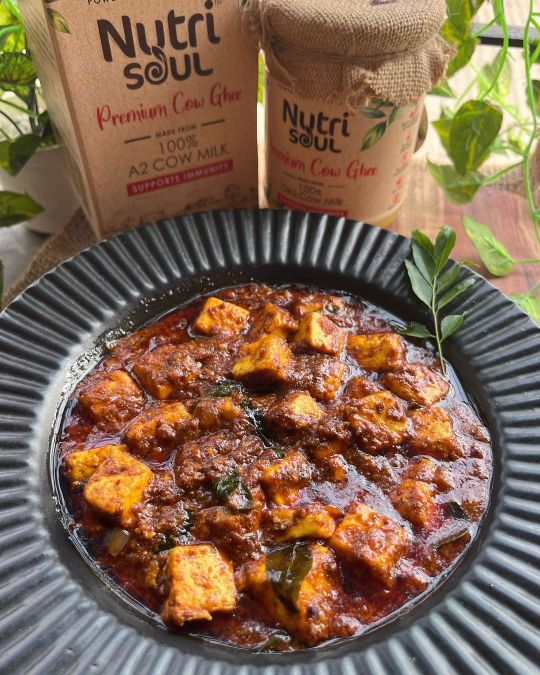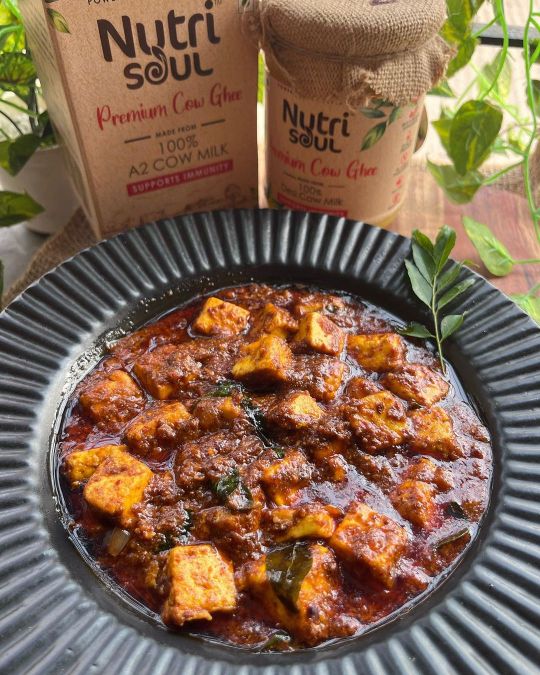Text
From Farm to Table: How is Pure A2 Cow Ghee Made and Why Does It Matter?

Pure A2 Cow Ghee production at Nutrisoul follows a meticulous process, highlighting the brand's commitment to quality and health. It all starts with sourcing milk from select Indian breeds like Gir and Sahiwal, which naturally produce A2 milk rich in A2 beta-casein protein. This protein is believed to be easier to digest and less likely to cause sensitivities compared to A1 beta-casein found in conventional milk.
The milk collected undergoes stringent quality checks to ensure it's free from antibiotics and hormones. It's then gently and traditionally churned into butter, preserving its natural nutritional profile. This butter is slowly heated to allow the separation of water and milk solids, leaving behind the golden liquid – ghee.
The next step involves simmering this pure butter over an open flame. This slow-cooking process prevents scorching and helps eliminate any remaining moisture and impurities. The result is Nutrisoul's signature A2 cow ghee, a rich, aromatic, and flavorful product.
Why does this process matter? Nutrisoul emphasizes the significance of the A2 milk source. Research suggests that A2 milk might be more suitable for some individuals, especially those with dairy sensitivities. By focusing on A2 milk, Nutrisoul aims to provide ghee that can be enjoyed by a wider range of people.
Traditional production methods are another crucial aspect. The slow churning and simmering not only contribute to the ghee's distinct taste but also help retain essential nutrients and compounds. This attention to detail aligns with the brand's goal to offer ghee that's not only delicious but also preserves the potential health benefits associated with ghee.
In essence, Nutrisoul's Pure A2 Cow Ghee stands as a testament to the brand's dedication to crafting a product that merges tradition, quality sourcing, and potential health advantages. From farm to table, every step is carefully orchestrated to deliver a premium ghee that caters to the discerning consumer who seeks not just taste, but also the potential benefits of A2 cow dairy.
0 notes
Text
Cooking with A2 Cow Ghee: Enhancing Flavor and Nutrition | Nutrisoul

Cooking with A2 cow ghee can indeed enhance the flavor and nutrition of your dishes. A2 cow ghee is known for its unique taste and numerous health benefits. Here's how using A2 cow ghee in your cooking can improve the overall culinary experience:
Rich Flavor:
A2 cow ghee has a distinct, nutty, and buttery flavor that enhances the taste of various dishes. It adds a delicious depth of flavor, making your food more enjoyable and appetizing.
High Smoke Point:
A2 cow ghee has a high smoke point, which means it can withstand high heat without breaking down and releasing harmful compounds. This makes it ideal for sautéing, frying, and deep-frying, as it won't burn easily and preserves the flavor of the ingredients.
Versatility:
A2 cow ghee is incredibly versatile and can be used in various cooking methods, such as frying, roasting, baking, and even as a finishing touch to dishes. It complements both sweet and savory dishes.
Health Benefits:
A2 cow ghee is rich in essential fatty acids, vitamins (A, D, E, and K), and antioxidants. When used in moderation, it can provide several health benefits, including improved digestion, better absorption of fat-soluble vitamins, and support for a healthy immune system.
Lactose and Casein-Free:
A2 cow ghee is typically free from lactose and casein, making it suitable for individuals with lactose intolerance or dairy allergies. The clarification process involved in making ghee removes these components, leaving behind the pure butterfat.
Enhancing Aromatics:
When you cook with A2 cow ghee, its rich flavor infuses the dish with aromatic notes, enhancing the overall taste and aroma of the food.
Extended Shelf Life:
Ghee has a longer shelf life compared to butter, as the moisture and milk solids are removed during the clarification process. This makes it a more stable cooking fat that can be stored at room temperature for an extended period without spoilage.
Tips for Cooking with A2 Cow Ghee:
Use it as a Cooking Fat: Replace vegetable oils or regular butter with A2 cow ghee when cooking. Its high smoke point and rich flavor make it an excellent choice for frying, sautéing, and searing.
Baking: Incorporate A2 cow ghee into baking recipes for added flavor and moisture. It works well in cakes, cookies, and pastries.
Seasoning and Finishing: Drizzle melted A2 cow ghee over finished dishes, such as roasted vegetables, grilled meats, or cooked grains, to enhance the flavor and add a glossy finish.
Tadka (Tempering): In Indian cuisine, tadka or tempering is a popular technique. Heat A2 cow ghee with spices and herbs and pour it over dal, curries, or lentils to intensify the flavors.
Ghee-based Sauces: Use A2 cow ghee to make flavorful sauces for pasta, rice, or vegetables by infusing it with herbs and spices.
Remember that while A2 cow ghee has numerous benefits, it is still a fat, and moderation is key. Incorporate it as part of a balanced diet to enjoy its flavor and nutritional advantages while maintaining a healthy lifestyle.
0 notes
Text
The Role of A2 Cow Ghee in Ayurveda and Traditional Medicine

Ayurveda, the ancient Indian system of medicine, places great emphasis on natural remedies and dietary practices for maintaining optimal health. A2 cow ghee, derived from specific cow breeds, has been an integral part of Ayurvedic practices for centuries. In this article, we will explore the significant role of A2 cow ghee in Ayurveda and traditional medicine, highlighting its potential benefits for overall well-being.
Ayurvedic Perspective on A2 Cow Ghee:
Explain the foundational principles of Ayurveda and its view on A2 cow ghee. Discuss how Ayurveda considers A2 cow ghee to be a vital component in balancing the body, mind, and spirit, and its classification as a "sattvic" food that promotes harmony and nourishment.
Nutritional and Therapeutic Properties of A2 Cow Ghee:
Explore the nutritional composition of A2 cow ghee and its therapeutic properties according to Ayurvedic texts. Discuss its rich content of essential fatty acids, vitamins, antioxidants, and beneficial compounds. Highlight how these properties are believed to support various bodily functions and contribute to overall health and well-being.
Digestive Benefits of A2 Cow Ghee:
Discuss the specific benefits of A2 cow ghee for digestive health according to Ayurveda. Explore how it is believed to enhance digestion, strengthen the digestive fire (agni), promote nutrient absorption, and alleviate digestive discomforts such as bloating and indigestion.
A2 Cow Ghee in Detoxification and Cleansing:
Explain how A2 cow ghee is used in Ayurvedic detoxification and cleansing practices. Discuss its role in lubricating the body's tissues, facilitating the removal of toxins, and supporting the elimination process. Highlight its potential benefits in Ayurvedic practices like Panchakarma.
A2 Cow Ghee for Mind and Mental Health:
Explore the connection between A2 cow ghee and mental well-being in Ayurveda. Discuss how it is believed to nourish the brain and nervous system, promote mental clarity, and support cognitive functions. Explain its potential use in Ayurvedic practices aimed at reducing stress, anxiety, and promoting overall emotional balance.
A2 Cow Ghee in Ayurvedic Herbal Formulations:
Discuss the incorporation of A2 cow ghee in Ayurvedic herbal formulations (medicines). Highlight its role as a carrier for herbs, enhancing their bioavailability and therapeutic effects. Provide examples of traditional Ayurvedic formulations that include A2 cow ghee.
External Applications of A2 Cow Ghee:
Explore the use of A2 cow ghee in external applications in Ayurveda. Discuss its potential benefits for skincare, promoting wound healing, soothing inflammation, and supporting joint health. Highlight specific Ayurvedic practices such as abhyanga (oil massage) and nasya (nasal administration).
Traditional Wisdom and Modern Research:
Discuss how traditional Ayurvedic wisdom regarding A2 cow ghee is being supported by modern scientific research. Cite relevant studies that explore its nutritional composition, health benefits, and potential therapeutic applications. Emphasize the need for further research to validate Ayurvedic claims.
A2 cow ghee holds a significant place in Ayurveda and traditional medicine, valued for its nutritional properties and therapeutic benefits. According to Ayurvedic principles, incorporating A2 cow ghee into the diet and utilizing it in various Ayurvedic practices may support digestion, detoxification, mental well-being, and overall health. However, it is important to consult with a qualified Ayurvedic practitioner or healthcare professional for personalized guidance on incorporating A2 cow ghee into your lifestyle based on individual needs and health conditions. For pure A2 cow ghee choose Nutrisoul.
0 notes
Text
A2 Cow Ghee and Skin Health: Unlocking the Beauty Benefits | Nutrisoul

A2 cow ghee, derived from the milk of specific cow breeds that produce A2 beta-casein protein, has been associated with potential benefits for skin health. While scientific research specifically on the beauty benefits of A2 cow ghee is limited, certain properties of ghee and anecdotal evidence suggest its potential positive effects on the skin:
Moisturization: Ghee is a natural moisturizer and can help hydrate the skin. Its rich fatty acid content helps to nourish and soften the skin, reducing dryness and promoting a healthy complexion.
Vitamin Content: A2 cow ghee contains fat-soluble vitamins such as vitamins A, D, E, and K, which are known to be beneficial for skin health. These vitamins contribute to maintaining healthy skin, supporting its elasticity, and protecting against damage caused by free radicals.
Antioxidant Properties: Ghee, including A2 cow ghee, contains antioxidants like vitamin E and beta-carotene. Antioxidants help in neutralizing free radicals that can lead to skin damage, premature aging, and dullness.
Anti-Inflammatory Effects: Ghee contains butyric acid, a short-chain fatty acid known for its anti-inflammatory properties. Inflammation can contribute to skin conditions like acne, eczema, and psoriasis. The anti-inflammatory effects of ghee may help soothe and calm the skin.
Ayurvedic Tradition: In Ayurvedic practices, ghee has been used for centuries in skincare rituals. It is believed to have nourishing and rejuvenating effects on the skin, promoting a healthy and radiant complexion.
It's important to note that individual responses may vary, and the impact of A2 cow ghee on skin health can depend on factors such as skin type, sensitivity, and overall skincare routine. It's recommended to consult with a dermatologist or skincare professional for personalized advice and to ensure that the use of A2 cow ghee aligns with your specific skincare needs and goals.
Additionally, while incorporating A2 cow ghee into your skincare routine may offer potential benefits, it's essential to maintain a holistic approach to skincare, including a balanced diet, proper hydration, regular skincare practices, and protection from environmental factors like UV radiation. Choose Nutrisoul to get the best A2 cow ghee online in India.
0 notes
Text
Incorporating A2 Cow Ghee into Your Daily Diet: Tips and Recipes | Nutrisoul

A2 cow ghee has gained popularity for its numerous health benefits and rich flavor. If you're looking to incorporate this nutritious ingredient into your daily diet, we've got you covered. In this blog post, we'll share some valuable tips and delicious recipes that will help you make the most of A2 cow ghee.
Start with Small Amounts: If you're new to A2 cow ghee, it's best to start with small amounts and gradually increase your intake. This will allow your body to adjust to this unique ingredient.
Substitute for Cooking Oils: A2 cow ghee has a high smoke point, making it an excellent substitute for cooking oils like vegetable oil or olive oil. Use it for sautéing vegetables, frying, or even baking.
Enhance the Flavor of Dishes: A2 cow ghee has a rich, nutty flavor that can enhance the taste of your favorite dishes. Add a dollop of ghee to your cooked rice, pasta, or steamed vegetables for an extra burst of flavor.
Spread it on Toast: Replace your regular butter or spreads with A2 cow ghee on your morning toast. It adds a delightful taste and provides essential fatty acids.
Blend it into Your Morning Coffee or Tea: For a creamy and indulgent twist, try adding a teaspoon of A2 cow ghee to your morning coffee or tea. It gives a unique flavor and provides a sustained energy boost.
Make Homemade Ghee-based Salad Dressings: Create your own healthy salad dressings using A2 cow ghee as the base. Mix it with lemon juice, herbs, and spices for a delicious and nutritious dressing.
Prepare Traditional Indian Dishes: A2 cow ghee is widely used in traditional Indian cuisine. Experiment with recipes like ghee-roasted rotis, ghee-infused lentils, or ghee-based curries to experience the authentic flavors.
Bake with A2 Cow Ghee: Incorporate A2 cow ghee into your baking recipes for a moist and flavorful result. Use it in cookies, cakes, or bread to add a unique twist to your baked goods.
Enjoy Ghee-Drizzled Popcorn: Popcorn lovers can rejoice by drizzling melted A2 cow ghee over their freshly popped kernels. It adds a buttery richness and elevates the snacking experience.
Make Ghee-infused Herbal Infusions: A2 cow ghee can act as a carrier for the flavors and benefits of various herbs. Infuse ghee with herbs like turmeric, ginger, or cinnamon, and enjoy the added wellness benefits in your meals.
Remember to source high-quality, organic A2 cow ghee for the best results. Incorporating A2 cow ghee into your daily diet not only enhances the taste of your meals but also provides you with essential nutrients and potential health benefits. So, get creative in the kitchen and explore the wonderful world of A2 cow ghee. Choose Nutrisoul to get the best A2 cow ghee in India.
0 notes
Text
0 notes
Text
What is the Bilona process of making A2 ghee? | Nutrisoul

The Bilona process is a traditional method of making ghee from A2 milk that involves several steps. Here's an overview of the Bilona process:
Milk Collection: Fresh A2 milk from indigenous cow breeds, such as Gir, Sahiwal, or Desi cows, is collected.
Curdling: The collected milk is allowed to naturally curdle by adding a natural curdling agent like buttermilk or curd. This helps in separating the milk into curds (solid portion) and whey (liquid portion).
Churning: The curds obtained from the previous step are churned using a wooden churner or traditional hand-operated churner called "bilona." This process breaks down the curds and separates the fat globules from the liquid. The continuous churning creates a creamy consistency.
Heating: The churned curds, along with the cream, are transferred to a heavy-bottomed vessel or kadai and heated on a low flame. The heating process slowly evaporates the moisture content, and the fat separates from the liquid.
Clarification: As the mixture heats up, the milk solids settle at the bottom, and the pure ghee (clarified butter) rises to the top. The impurities and milk solids are carefully removed, and the ghee is strained to achieve a clear, golden liquid.
Cooling and Packaging: Once the ghee is ready, it is allowed to cool down to room temperature. It solidifies into a semi-solid consistency. The ghee is then transferred to containers or jars for storage.
The Bilona process is believed to retain the natural qualities and flavors of the A2 milk, resulting in a rich, aromatic, and nutrient-rich A2 ghee. This traditional method requires patience and meticulousness to produce high-quality ghee.
It's worth noting that the Bilona process may vary slightly based on regional practices and individual preferences. Some variations may include the use of specific utensils, heating durations, and other specific techniques passed down through generations. Choose Nutrisoul to buy the best A2 cow ghee in India online.
0 notes
Text
0 notes
Text
What are the key health benefits of Gir Cow Ghee | Nutrisoul

Gir Cow Ghee, a type of clarified butter made from the milk of Gir cows, is known for its health benefits. Here are some key health benefits associated with Gir Cow Ghee:
Rich in Nutrients: Gir Cow Ghee is a good source of essential nutrients. It contains vitamins such as A, D, E, and K, as well as important minerals like calcium and phosphorus. These nutrients are vital for maintaining healthy bones, supporting the immune system, and promoting overall well-being.
Digestive Health: Gir Cow Ghee is known for its digestive properties. It helps stimulate the secretion of digestive enzymes, which aids in the breakdown and absorption of nutrients from food. Ghee can also provide relief from common digestive issues like constipation and indigestion.
Anti-Inflammatory Properties: Ghee derived from Gir cows is believed to have anti-inflammatory properties. It contains butyric acid, a short-chain fatty acid known for its anti-inflammatory effects on the body. Regular consumption of Gir Cow Ghee may help reduce inflammation in the body, which is associated with various chronic conditions.
Supports Heart Health: Contrary to popular belief, moderate consumption of Gir Cow Ghee can be beneficial for heart health. It contains healthy fats, including monounsaturated fats, which can help maintain healthy cholesterol levels and reduce the risk of heart disease when consumed as part of a balanced diet.
Boosts Immune System: The presence of vitamins and antioxidants in Gir Cow Ghee can help strengthen the immune system. These nutrients support the body's defense against infections and diseases, promoting overall immune health.
Enhances Brain Function: Ghee is considered a brain-boosting food in traditional Ayurvedic practices. The healthy fats present in Gir Cow Ghee are believed to nourish the brain and support cognitive function. It is also said to aid memory retention and improve concentration.
Skin and Hair Health: Gir Cow Ghee can be used topically or consumed to improve skin and hair health. It helps moisturize the skin, reduce dryness, and improve skin elasticity. When used in hair care, it may promote hair strength, shine, and overall scalp health.
It is important to note that while Gir Cow Ghee offers potential health benefits, moderation is key. Like any other food, it should be consumed as part of a balanced diet and in accordance with individual dietary requirements and health conditions. Consulting with a healthcare professional or nutritionist is advised before making any significant changes to your diet. Nutrisoul takes care of your health and provides you the purest A2 cow ghee online.
0 notes
Text
0 notes
Text
An ultimate guide to the common myths and misconceptions of ghee | Nutrisoul

Ghee, a form of clarified butter, has been used for centuries in traditional cooking and Ayurvedic practices. However, there are several myths and misconceptions surrounding ghee that can cause confusion. Here's an ultimate guide to debunking common myths and misconceptions about ghee:
Myth 1: Ghee is unhealthy and leads to weight gain.
Fact: Ghee is a concentrated source of calories and fat, but it can be part of a healthy diet when consumed in moderation. Ghee contains healthy fats, such as monounsaturated fats and omega-3 fatty acids, which can be beneficial for overall health. However, excessive consumption of any fat, including ghee, can contribute to weight gain. Portion control is important to maintain a balanced diet.
Myth 2: Ghee is high in cholesterol.
Fact: Ghee does contain cholesterol, but it is important to note that dietary cholesterol has less impact on blood cholesterol levels than saturated and trans fats. The relationship between dietary cholesterol and blood cholesterol levels is complex and varies among individuals. However, moderate consumption of ghee is unlikely to have a significant impact on cholesterol levels in healthy individuals.
Myth 3: Ghee is not suitable for lactose-intolerant individuals.
Fact: Ghee is made by removing the milk solids from butter, which includes the lactose and proteins. This makes ghee virtually lactose-free, and it can be tolerated by many individuals with lactose intolerance. However, individuals with severe lactose intolerance should exercise caution and may want to consult with a healthcare professional before consuming ghee.
Myth 4: Ghee is bad for heart health.
Fact: Ghee is often misunderstood as harmful to heart health due to its high saturated fat content. However, recent research suggests that the relationship between saturated fats and heart disease is more complex than previously believed. While excessive consumption of saturated fats can increase the risk of heart disease, moderate consumption of ghee, along with an overall healthy diet, can be part of a balanced approach to heart health.
Myth 5: Ghee can be used as a substitute for butter or oil in any recipe.
Fact: While ghee can be a versatile cooking fat, it may not be suitable as a direct substitute for butter or oil in all recipes. Ghee has a distinct flavor and can enhance the taste of certain dishes. Additionally, its smoke point is higher than butter but lower than some oils, so it may not be suitable for high-heat cooking methods. It is best to use ghee where its unique flavor and properties complement the recipe.
Myth 6: Ghee is only used in traditional Indian cooking.
Fact: While ghee is widely used in Indian cuisine, its popularity has extended beyond traditional cooking. It is now embraced by many culinary enthusiasts and health-conscious individuals around the world. Ghee's rich, nutty flavor and high smoke point make it suitable for various cooking methods, including sautéing, frying, baking, and even as a spread.
Remember, individual dietary needs and health conditions can vary, so it is always a good idea to consult with a healthcare professional or a registered dietitian if you have specific concerns about incorporating ghee into your diet.
0 notes
Text
0 notes
Text
What is the difference between normal and desi cow ghee A2? | Nutrisoul

The difference between normal cow ghee and desi cow ghee A2 lies in the type of cow milk used to produce them, specifically in the composition of the beta-casein protein. Here are the key distinctions:
Cow Milk Source: Normal cow ghee is typically made from the milk of both indigenous (desi) and hybrid breeds of cows, which may include cows with A1 and A2 beta-casein proteins. Desi cow ghee, on the other hand, is specifically made from the milk of indigenous breeds of cows, such as Gir, Sahiwal, or Red Sindhi, which are known to predominantly produce A2 milk.
A2 Beta-Casein Protein: The main differentiating factor is the composition of the beta-casein protein present in the milk. Normal cow milk contains a mix of A1 and A2 beta-casein proteins, whereas desi cow milk predominantly contains A2 beta-casein protein.
Digestibility: Advocates of A2 milk claim that A2 beta-casein protein is more easily digested by the human body compared to A1 beta-casein protein. Some individuals who experience discomfort or digestive issues after consuming normal cow milk may find that consuming A2 milk, and subsequently A2 ghee, is better tolerated.
Health Benefits: Proponents of A2 milk and A2 ghee suggest various potential health benefits. It is believed that A2 ghee may have anti-inflammatory properties, promote gut health, support cardiovascular health, and provide other nutritional advantages. However, it's important to note that scientific studies in this area are limited, and more research is needed to fully understand the potential health effects.
It's worth mentioning that the quality and production process of ghee can vary among different brands and manufacturers, regardless of whether it is made from normal cow milk or desi cow milk. It's important to choose ghee from reputable sources that ensure high-quality ingredients and follow proper manufacturing practices.
Ultimately, the choice between normal cow ghee and desi cow ghee, specifically A2 ghee, depends on personal preferences, dietary considerations, and any specific health concerns. Consulting with a healthcare professional or nutritionist can provide personalized advice based on your individual needs.
0 notes


